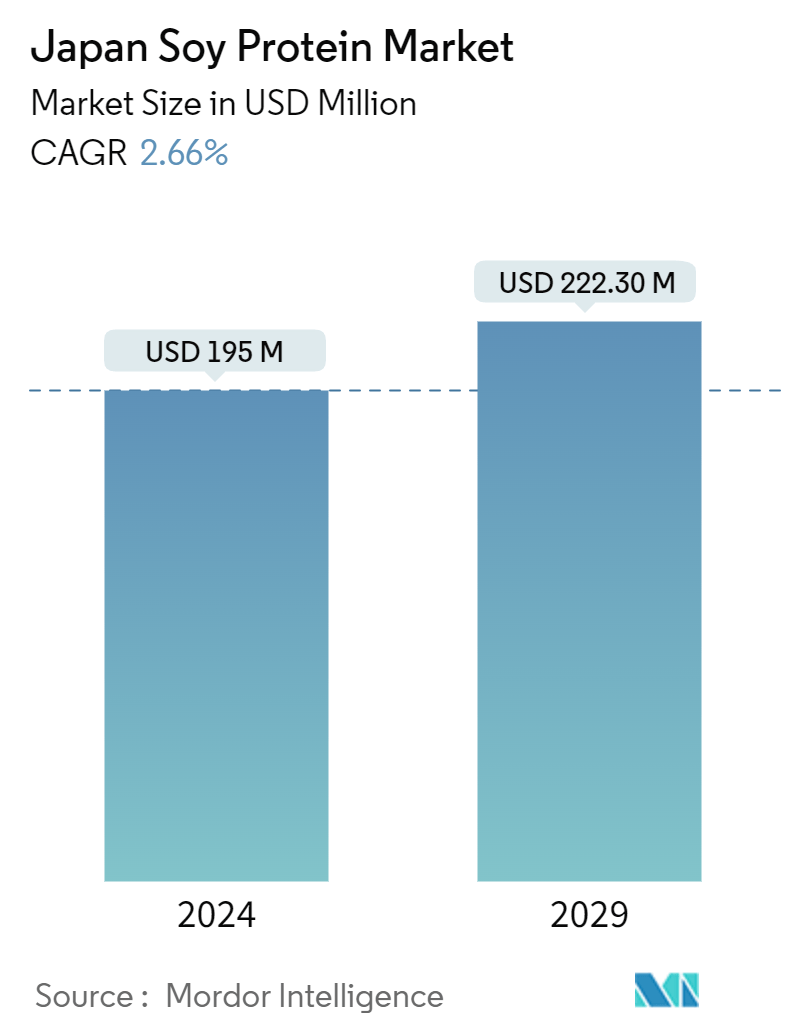Market Size of Japan Soy Protein Industry

| Study Period | 2019 - 2029 |
| Base Year For Estimation | 2023 |
| Market Size (2024) | USD 195 Million |
| Market Size (2029) | USD 222.30 Million |
| CAGR (2024 - 2029) | 2.66 % |
| Market Concentration | Low |
Major Players
*Disclaimer: Major Players sorted in no particular order |
Japan Soy Protein Market Analysis
The Japan Soy Protein Market size is estimated at USD 195 million in 2024, and is expected to reach USD 222.30 million by 2029, growing at a CAGR of 2.66% during the forecast period (2024-2029).
- Soy protein is used in different foods and beverages as the demand for plant-based food and beverage products is increasing in the country. Soy proteins are easily digestible and provide higher nutrients than animal meat. Owing to this, the use of soy protein in meat substitutes is increasing. Soybeans are a powerful legume that can easily replace meat as it provides a meat-like texture.
- Soy-fortified milk also observed high demand because of comparable protein, calcium, vitamins A and D, and B vitamins content to cow's milk. The demand for soy milk is increasing in the country due to rising lactose intolerance. According to JSMA data from 2022, the shipment volume of soy milk in Japan was 126.3 thousand liters. Furthermore, the demand for soy protein in sports nutrition and infant food is also increasing due to its nutritional and functional properties.
- According to the United States Department of Agriculture data from 2022, the production of soybeans in Japan was 238 thousand tons. Owing to the increasing production, the processing of soya is also increasing in the country. The market players are launching and innovating new soy proteins for a wide range of applications. For instance, Hollywood Cosmetics Japan provides a range of soy proteins for beauty and health. Soy protein is used in cosmetics and personal care products as it holds moisture in the skin for a longer time and provides glowing, healthy skin. According to Mitsubishi Chemical Corporation data from 2021, monthly household expenditure on personal care products in Japan was USD 26.96. Owing to this, the demand for soy protein in personal care products is growing. Although the use of soy protein is increasing in the country, the presence of other plant-based proteins like hemp protein, pea protein, potato protein, and others is expected to restrict the growth of the market.
Japan Soy Protein Industry Segmentation
Soy protein is extracted from the processing of soy. Soy protein is used in different food products to increase their nutritional value.
Japan's soy protein market is segmented by for into concentrates, hydrolysates, and isolates. By end user, the market is segmented into animal feed, personal care and cosmetics, food and beverages, and supplements. The food and beverage segment is further segmented into bakery, beverages, breakfast cereals, condiments/sauces, dairy and dairy alternative products, RTE/RTC food products, and snacks.
For each segment, the report offers the market size in value terms in USD and volume terms in tons for all the abovementioned segments.
| Form | |
| Concentrates | |
| Hydrolyzed | |
| Isolates |
| End-User | |||||||||
| Animal Feed | |||||||||
| Personal Care and Cosmetics | |||||||||
| |||||||||
|
Japan Soy Protein Market Size Summary
The Japan soy protein market is experiencing a notable expansion, driven by the increasing consumer preference for plant-based food and beverages. This shift is largely attributed to the rising trend of veganism and health consciousness among consumers, who are seeking alternatives to animal-based products due to concerns over nutrition and digestibility. Soy protein, known for its high nutrient content and digestibility, is increasingly being used in meat substitutes and dairy alternatives, such as soy-fortified milk, which is gaining popularity due to the high prevalence of lactose intolerance in the country. The market is also witnessing a surge in demand for soy protein in sports nutrition and infant food, as it offers significant nutritional and functional benefits. The growing production and processing of soybeans in Japan further support this market growth, with companies innovating and launching new soy protein products for diverse applications, including cosmetics and personal care.
The market landscape is characterized by a fragmented structure, with major players like Archer Daniels Midland Company, CHS Inc., DuPont de Nemours Inc., and others actively participating in the market. These companies are focusing on product innovation and strategic initiatives such as expansions, acquisitions, and partnerships to meet the rising demand for plant-based proteins. The demand for soy protein is particularly strong among health-conscious consumers and sports enthusiasts, who are incorporating it into their diets for its energy-boosting and muscle-building properties. Despite the competitive presence of other plant-based proteins like hemp and pea protein, soy protein continues to hold a significant share of the market, supported by its versatile applications and the ongoing trend towards plant-based diets.
Japan Soy Protein Market Size - Table of Contents
-
1. MARKET DYNAMICS
-
1.1 Market Drivers
-
1.1.1 Increasing Demand for Protein-Rich Food
-
1.1.2 Increasing Demand for Plant-Based and Organic Ingredients
-
-
1.2 Market Restraints
-
1.2.1 Presence of Alternative Proteins
-
-
1.3 Porter's Five Forces Analysis
-
1.3.1 Threat of New Entrants
-
1.3.2 Bargaining Power of Buyers/Consumers
-
1.3.3 Bargaining Power of Suppliers
-
1.3.4 Threat of Substitute Products
-
1.3.5 Intensity of Competitive Rivalry
-
-
-
2. MARKET SEGMENTATION
-
2.1 Form
-
2.1.1 Concentrates
-
2.1.2 Hydrolyzed
-
2.1.3 Isolates
-
-
2.2 End-User
-
2.2.1 Animal Feed
-
2.2.2 Personal Care and Cosmetics
-
2.2.3 Food and Beverages
-
2.2.3.1 Bakery
-
2.2.3.2 Beverages
-
2.2.3.3 Breakfast Cereals
-
2.2.3.4 Condiments/Sauces
-
2.2.3.5 Dairy and Dairy Alternative Products
-
2.2.3.6 RTE/RTC Food Products
-
2.2.3.7 Snacks
-
-
2.2.4 Supplements
-
2.2.4.1 Baby Food and Infant Formula
-
2.2.4.2 Elderly Nutrition and Medical Nutrition
-
2.2.4.3 Sport/Performance Nutrition
-
-
-
Japan Soy Protein Market Size FAQs
How big is the Japan Soy Protein Market?
The Japan Soy Protein Market size is expected to reach USD 195 million in 2024 and grow at a CAGR of 2.66% to reach USD 222.30 million by 2029.
What is the current Japan Soy Protein Market size?
In 2024, the Japan Soy Protein Market size is expected to reach USD 195 million.

